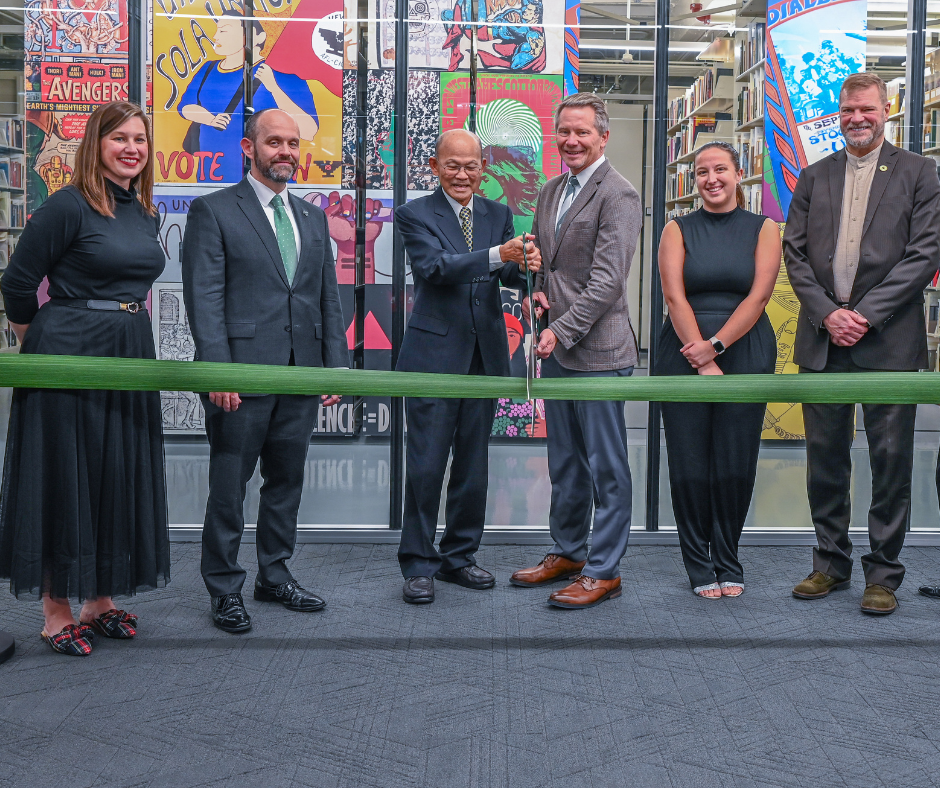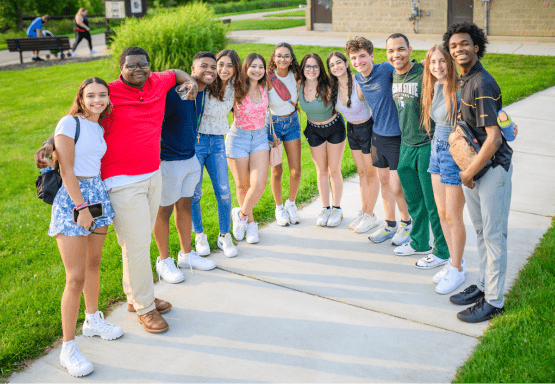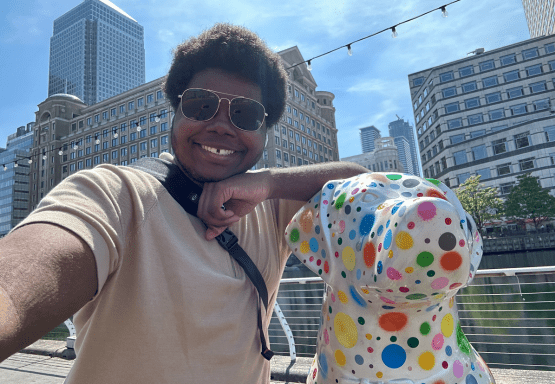
At the 2024 Grand Awards, Keelung Hong and the late Stephen O. Murray, a Madison alumnus, were honored with the Philanthropist Award for their impact on MSU.
This story, which details Hong and Murray's generous support of MSU Libraries, originally appeared on the MSU University Advancement website. The photo above (credit: Derrick L. Turner) is from the ceremonial ribbon cutting celebrating the reopening of MSU Libraries’ renovated Special Collections on Nov. 22, 2024.
There is a place within MSU Libraries where thousands of treasures reside. It is a bright space full of bold voices from across centuries that speak truths of tomorrow and fearlessly toss new, bold ideas from cover to cover. Here, vibrant heroes shout from moving stacks, 300,000 comics strong. Every voice is uplifted beyond the margins. Here, adventurers of thought discover new ideas from a collection that breaks through the fog of the moment and propels us into the emerging future. This is the MSU Libraries Stephen O. Murray and Keelung Hong Special Collections, where — now in a newly renovated space at MSU Libraries Main 3-East — ideas grow as tall as sequoias.
Faculty, students, community members and researchers from around the world come to MSU Libraries to explore the extensive array of over 500,000 printed works in the renowned Special Collections. Formally established as a unit within the Libraries in 1962, the purpose of the collection was to house special materials and build, preserve and make accessible important research collections for educational use. Ever since then, the collection equally informs and unites individual and collective voices.
Seeds of Thought
Research was always top of mind for Dr. Stephen O. Murray (1950-2019), the man whose legacy is embedded within the Special Collections. Stephen, a James Madison alum from Minnesota, was a sociologist, anthropologist and comparative historian who published in a variety of topics, such as sexual and gender diversity, sociolinguistics and the history of social sciences.
Whenever he and his partner, Dr. Keelung Hong, would ponder a current societal issue, or simply wonder if something was possible, his mantra was “Let’s do the Research!”
Together, Stephen and Keelung would scour the Special Collections for materials written by authors throughout the ages until they found what they were looking for—and if they couldn’t find a book dedicated to their subject, then Stephen would write the book himself.
As a gift to the MSU Libraries, Keelung donated Stephen’s life works to the Special Collections where they can continue to inform and inspire those on their own quests of research. Additionally, funding Special Collections with a $5 million gift in Stephen’s memory is something Keelung is joyfully humble about. “Stephen’s name comes first. This is because of him, and I am lucky to be able to do it.”
The world-class collections further cement MSU’s place on the map as a top-tier research institution, says Libraries Dean Neil Romanosky. Notably, the Special Collections was one of the reasons he felt drawn to MSU and became dean of Libraries in 2023.
The highly accessible collection includes an exhaustive variety of works: comic books, ancient texts, cookbooks, almanacs, manuscripts, vinyl records and ephemera. It is an invaluable resource to Spartans on campus and researchers from across the globe. Dean Romanosky is quick to emphasize that the Special Collections exist because of the dedication of donors.
“It would not be possible without the generosity of our donors, particularly the collections’ namesakes, Stephen O. Murray and Keelung Hong,” says Dean Romanosky. “We are grateful for both the impact of their support and the legacy it has already created, especially as we move toward opening our new Special Collections space.”
For more than 20 years, librarians wanted to move the Special Collections from the basement of the Main Library to a more secure, climate-controlled and protected space. This endeavor is finally becoming a reality. The new renovation will move the entire collection to a fully updated space on the third floor of the Main Library’s East Wing.
As Keelung recently toured the partially completed renovation, his smile radiated as he perused the many shelves waiting to be filled.
Keelung is thrilled that the collection will be protected and cared for in the new state-of-the-art space where librarians can easily work together and nurture new research. "That's the impact that the Special Collections can have," says Keelung. "It is real, real research. It is going to help people that we can even imagine."
Turning a New Leaf
A walnut ceiling will grace the entryway of the Special Collections, beckoning inquisitive minds with the wood-grain memory of years gone by. A little further down the wide hallway is the main collection area filled with tall bookshelves stacked together in a climate-controlled glass room. Librarians move the stacks seamlessly by using a digital control pad on the side of each shelf.
Renovations of the 26,000-square-foot space include premium storage with climate control and fire suppression systems to provide additional protection for the valuable materials. An additional two rooms with viewing windows are planned for collections processing.
Just behind the stacks lies the vault, the “jewel box” of the entire collection. A shimmering lighted green entrance will open into a 1,500-square-foot room, carefully secured to hold the most precious items in the collection.
Inside the vault, a fine reading table made from reclaimed campus trees waits for researchers to pore over its surface, studying Shakespeare’s portfolio, the first American edition of the second cookbook to be printed in the U.S. authored by Susannah Carter with plates created by Paul Revere or an ancient tablet from 1800 BCE Mesopotamia (a receipt for the sale of sheep in cuneiform script engraved in the clay).
Until now, Special Collections librarians, archivists and support staff were scattered throughout the Main Library. Now, they will all work together, in offices directly across from the collection rooms—their desks dappled with sunlight coming through UV-protected windows offering views of North Campus. Their creativity will have no bounds in a space that reflects the openness of the collection they steward. It will be the first time the unit is colocated, enabling further work together.
This environment of collaboration and openness is something the library is already known for. “Our goal is for everyone to be able to see themselves in our special collection,” says Leslie McRoberts, head of the Special Collections. And they do.
Reading to the Sky
Morgan Schwarz is a current student employee at the Libraries. As a third-year student studying history in the College of Social Science, she was looking for a job that would familiarize her with MSU and this job was a perfect fit. What started as an effort to get to know her university, turned into a love for books. She considers it a privilege to have access to such a vast collection of valuable works. “I look forward to going into work because I never know what I will find,” Morgan says.
There are fencing swords, sermons, celebrity phone books and even a book made of cheese kept in a refrigerator. Morgan’s job in Special Collections taught her research skills, how to properly handle historical objects and inspired her new passion for a career in Library Science.
It isn’t uncommon for students to gain a new appreciation of texts, history and the value of research after exploring the collection or taking the History of the Book class. Many new ideas take root and become the foundation for years of groundbreaking research in this very section of the Main Library.
Back when Special Collections was housed in the basement, a student visiting from UM-Flint was paging through card catalogs looking for books published on LGBTQ history. It was the '90s, a time when acceptance of such topics was rare. As he tediously continued his pre-digital search, a librarian walked up to him and offered to help.
Her presentation was classic librarian, and the student was terrified to share his research topic, given the time period. But he had nothing to fear. The librarian’s name was Anne Tracy, a dedicated library assistant and bibliographer who helped build several collections in the Libraries, including the LGBTQ+ collection. And she happily helped the student with
his research.
That student continued his education and eventually became an MSU faculty member himself. Dr. Tim Retzloff now teaches history and LGBTQ studies as a fixed-term assistant professor in the College of Social Science, and he considers his research in the Special Collections foundational to his work. “MSU Special Collections is the often-unsung repository of queer history and culture,” Tim says. Now he visits the Libraries with his students and has donated his own work, Come Out! In Detroit, to the Special Collections.
“When researchers want to and should try to understand marginalized people who are not often represented in mainstream sources, Special Collections is invaluable for maintaining material culture, because otherwise it would be easily lost,”
says Tim.
One researcher who sought to understand marginalized voices was Dr. Brian Rouleau, professor of history at Texas A&M University. He came all the way from the Lone Star State to conduct research on the rise and fall of romance comic books within American popular culture.
“Sometimes the comic book world can feel like a boys’ club,” Brian says. “Romance comics can help to show young women today the important role that girls—as audience, authors, artists and editors—have always played in mass media.”
Since the MSU Special Collections has the largest comic book collection in the world, it makes sense that he traveled to the Great Lakes State. He spent two weeks in the massive comic book archive, studying the history of romance comics.
While he found the collection amazing, the best part of his experience was interacting with the Special Collections librarians. “There’s just no substitute for the expertise and enthusiasm they bring to their work at the library,” Brian says. “Historians would be utterly lost without the diligent efforts of the librarians and archivists we depend on to do our work.”
Their efforts create experiences second to none. “There is nothing like holding in your hands the seeds of discovery that led to one’s chosen field,” says MSU Emerita Associate Professor Laura L. Symonds, Ph.D. For several years, she has brought Physiology students to the Special Collections before they embark on the “Foundations of Neuroscience” education abroad program. Students are given the opportunity to turn the pages of books that teach them how neuroscience discoveries began.
They can see the first anatomical drawings that medical students studied in Europe half a millennium ago, and even view drawings by Robert Hooke, who coined the term “cell” and viewed insects and plants magnified by the compound microscope in the 1600s. “[Students] start to gain an appreciation of the genius—and fortuitous luck—that gradually built the foundation of the field in which they are majoring at MSU,” says Laura.
Guardians of the Forest
The Libraries Special Collections are widely used by MSU faculty members and students—but, like Brian from Texas A&M, researchers from other universities rely on the collections as well. From Cornell University in New York, to Aberystwyth University in Wales and more, researchers have traveled to East Lansing to the Main Library along the Red Cedar to study rare materials that can only be found at Michigan State.
Accessibility is also increasing with digitization of certain works, such as Feeding America: The Historic American Cookbook Project. The online collection includes 76 cookbooks (out of 40,000) from MSU Libraries’ collection. So, if you need the definitive, original recipe for funeral potatoes or want to know what people in the 1950s took to a potluck — would you believe a lime Jell-O mold with banana peppers? — you can find it here.
While many encounters with items in the Special Collections require an appointment, items are often accessible in the Reading Room, through the History of the Book class, or through pop-up exhibits at the library.
This treasure trove of ideas within the MSU Libraries Special Collections is accessible to all, to read, research and create bold new stories. And as long as they exist through the generosity of donors like Keelung, the stories within will never get buried. “We live and breathe our mission,” says Leslie, “that these stories of love, the stories of hope, will continue to grow”—even taller than sequoias.
LEARN MORE about support for the Stephen O. Murray and Keelung Hong Special Collections by contacting MSU Libraries Director of Development Caitlyn Perry Dial at dialcait@msu.edu or by calling (517) 432-0032.



.png?h=384&iar=0&w=555)


